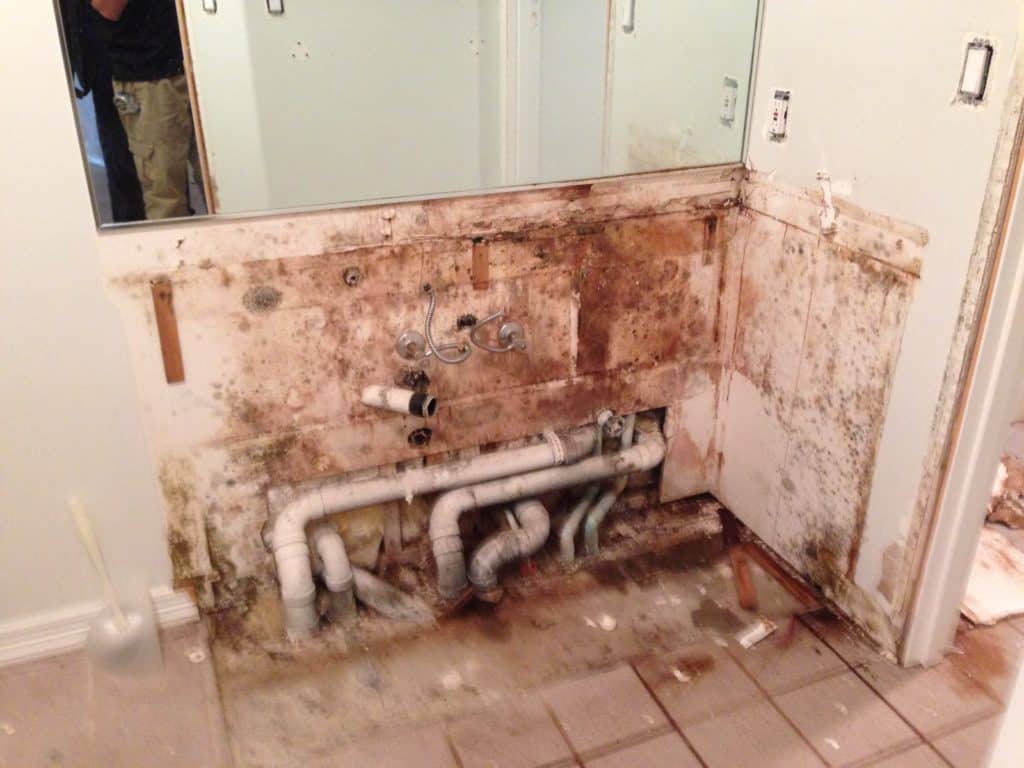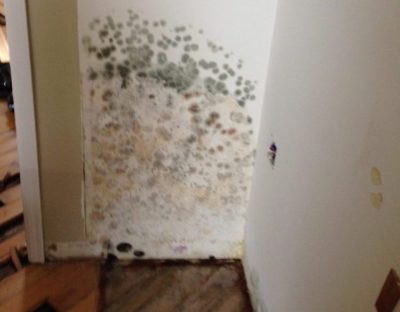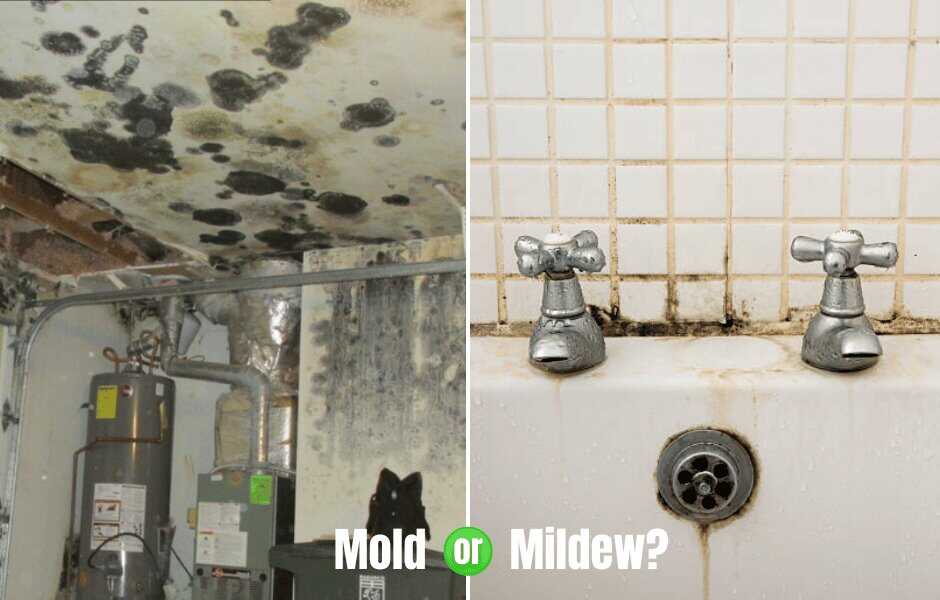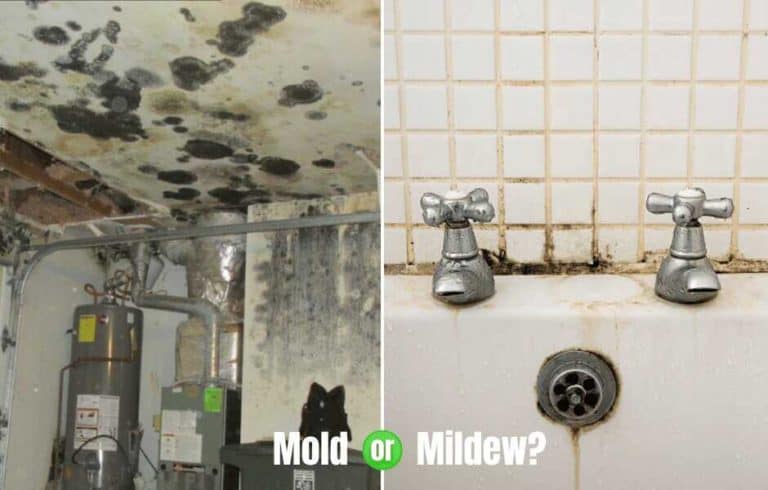Have you discovered some black or brown stuff in your shower? Grey fuzzy stuff on your walls? Perhaps someone told you “Maybe it’s mildew”, and now you’re wondering, “What even is the difference between mold vs mildew?”
Well, this is the right place to find the answers! This article draws on the experience of the experts at Cleaner Guys, a professional mold inspection and mold removal company. Read on to learn what you need to know about mildew and mold.
Table of Contents
- What is Mold?
- What is Mildew?
- Mold vs Mildew
- How to Clean Mildew
- How to Clean Mold
- When to Call a Mold Removal Company
- How to Prevent Mold Growth in the Future
- More Resources
- Key Takeaways
What is Mold?
The simplest and most basic definition of mold is that it’s a species of fungi. Mold typically appears as fuzzy black, green, or grey growth. It spreads by releasing spores into the air, not unlike dandelion seeds. Mold spores are in the air almost everywhere, all the time, just like dust. However, like most fungi, they will only land, root, and grow in a moist environment. That’s why when it comes to buildings, molds most often grow where there is previous or current water damage, such as a plumbing leak.
At Cleaner Guys, we deal with mold inspection and removal every day, and 90% of the time we only find mold in connection to water damage of some kind. Below are some images of mold from actual Cleaner Guys job sites, showing some of the places it likes to hide.

A prevalent place where we find mold is behind bathroom vanities. The plumbing in bathrooms often leaks quietly for a long time before anyone notices, which creates that perfect dark, damp environment for mold to grow. As you can see, mold usually looks like patchy, sometimes fuzzy dirtiness all over the walls.

Another common place we find mold growth is behind large appliances, such as behind the refrigerator in the photo above. Washing machines are another hotspot for mold. These appliances have water supply lines that feed water to them from the plumbing in the walls. These water supply lines can leak, but these appliances are not often moved, so nobody notices until the mold has already spread.
We have here described mold in a very practical sense, but if you would like an even more in-depth clinical explanation of molds, we recommend visiting the EPA’s page on molds.
What is Mildew?
Mildew is another form of fungi, and it’s so closely related to mold that it is actually considered a subspecies of mold. In fact, mold and mildew are closely related enough that they may occasionally overlap, or even grow in the same space, intermingled with one another. However, mildew still presents in ways that differentiate it from mold by color and growth pattern.
Given that mildew is a specific form of mold, and the main way to define mildew is in how it differentiates from mold, we will here go straight into the difference between the two.
Mold vs Mildew
The first differentiating factor between mold and mildew is color. While mold can appear black, grey, green, brown, and occasionally red, mildew presents as white in its early stages, and brown or black when it ages.
Structure and pattern are another way to tell mold and mildew apart. Mold grows in large spotty patches, feels fuzzy or grainy when touched, and is sometimes mistaken for dirt. Mildew’s growth pattern looks like clusters of very tiny dots, sometimes so small or dense they don’t even look like dots, particularly in places like shower grout.
Rooting is the most crucial difference of all, however. Mold roots deeply, eating its way far into drywall, wood, or whatever organic material it’s feeding on. Whatever mold growth you can see, there’s almost certainly a lot more you can’t see. Mildew, on the other hand, is partially defined by its shallow root growth. It roots so shallowly that it essentially grows on top of whatever organic material it’s on, hardly penetrating it at all.
This means that you’re far more likely to find mold on organic materials within a home, and mildew on hard, nonporous materials. For example, as illustrated by the photo below, mold’s favorite place to grow is damp drywall, where it can dig in deep and penetrate all the way through. Mildew, on the other hand, we most commonly find in bathtubs and showers, inside refrigerators, and inside washing machines.
Mildew is a surface-level fungus that grows on top of wet, hard surfaces. Mold is a fungus that roots deep into softer organic materials that are wet.

How to Clean Mildew
If the mold growth is white or brown, grows in very tiny dot patterns, and was found in your bathtub, shower, refrigerator, or washing machine, you’re most likely dealing with mildew. That’s a good thing! Mildew is usually very easily cleaned, because it doesn’t root deeply into the surface it grows on. You will likely be able to clean the mildew away by using any standard household cleaning chemical or vinegar, a scrubbing sponge or brush, and some elbow grease. Be sure to wear the proper PPE, including gloves and a mask!
If the mildew does not come off with the cleaning described above, we recommend that your next step be calling a mold inspection company to determine how best to remove or clean the mildew or mold.
How to Clean Mold
Mold typically roots deeply into the material it grows on. This makes it very difficult to clean with normal household cleaning methods, and it is often not possible to do so. Because the mold roots deeply, usually all of the drywall on which the mold is growing must be removed and replaced. This is not a process that should be attempted by anyone other than a professional mold removal specialist. However, if the mold is contained in a small enough area, cleaning by a layperson may be attempted.
If the Affected Area is Small
We recommend that if the mold is on an area of about 1 square foot or less, you can safely try cleaning it yourself before calling a mold removal company like Cleaner Guys. According to Homes & Gardens, a popular home remedy you can try is spraying vinegar on the affected area and letting it sit for at least an hour, making sure the room is ventilated, and then scrubbing the mold off thoroughly. However, we only suggest that you try vinegar on very small patches. We have found it ineffective on anything larger than a small patch because vinegar doesn’t penetrate deeply enough to kill areas of mold larger than 1 square foot.
Our most highly recommended method is purchasing a fungicide specifically designed to kill mold. Our favorite here at Cleaner Guys is Fiberlock Shockwave, a product we use regularly in our own work removing mold. We are not sponsored by or affiliated with Fiberlock Shockwave in any way. We simply find their product to be very effective.
If the Affected Area is Large
If the mold you discover covers an area greater than 1 square foot, you should not attempt to clean it yourself. It is almost certainly too deeply rooted to be easily cleaned off. If you rent the space where you found the mold, the first thing you should do is call your landlord and let them know about it immediately. Negotiate with them whether they will pay for a mold removal service or if you will, usually depending on whether the cause of the mold was the landlord’s fault or yours. If you own the property you found mold on, you’ll need to find and hire a mold removal company yourself.
When to Call a Mold Removal Company
If this article helped you determine that you have mold on your property, and not mildew, and the area is larger than 1 square foot, you should call a professional mold removal company immediately. Find out how to find a trustworthy service company here.
In addition, if you’re renting a house, and you’re unsure whether you or your landlord should have to pay for professional mold inspection and removal, read this section of our Ultimate Guide for Dealing With Apartment Mold. Keep in mind, this is NOT legal advice. If you have to figure out whether you or your landlord has to pay for mold removal in your house, we highly recommend that you consult a legal professional.

How to Prevent Mold Growth in the Future
Taking steps to make your property inhospitable to mold and mildew is essential moving forward. You certainly don’t want to have to deal with it again! Luckily, there are some simple things you can keep track of that will greatly reduce your chances of getting mold again in the future. Follow the steps below to make sure that in the future, you won’t have to struggle again to determine if your growth is mold vs mildew.
- Keep Indoor Humidity Low. We agree with the CDC’s recommendation to keep your indoor humidity ideally lower than 50%. Mold can only grow in a moist environment, and low humidity is a great way to reduce moisture throughout your property. Dehumidifiers are a great way to manage the humidity of your home.
- Take Care of Leaks Immediately. The longer water damage of any kind is left alone, the deeper the mold will root. Mold typically begins growing on any moist organic material within 48 hours. If you live in a rental home, alert your landlord about leaks and damaged window sealings immediately, pressing them about it as necessary and pointing out that it will cause mold they may have to fix.
- Ventilation, ventilation, ventilation! Try to have some kind of airflow in every room. Ceiling fans, freestanding fans, and even opening a window will do. Stagnant air encourages mold growth.
- Regular Cleaning. Mold feeds on organic materials like dust and crumbs — so don’t give it any!
More Resources
If you’ve discovered mold in an apartment, read this.
Discover the top 5 places mold hides here.
What happens if you touch mold? Read about the 3 things you will trigger.
Can mold or mildew make you sick? Read this article to find out what you need to know.
Key Takeaways
In the debate of mold vs mildew, there are a few simple indicators to look for. First, color: is the growth black, grey or green, or is it white or brown? Second, growth pattern: does the growth look like large fuzzy patches, or clusters of minuscule dots? And third, location. Is the mold growing on drywall, wood or other organic material? Or is it on the surface and cracks of a bathtub, refrigerator, or other such hard surface? Determine these factors, and you’ll have a good idea of whether you can clean the growth yourself, how to clean it, and when to call in professional mold removers.
If you find yourself in the unfortunate position of needing a professional mold inspection or removal company near Mount Vernon WA, consider Cleaner Guys as a high-quality, well-trusted option. We’re proud to boast award-winning customer service, honest pricing, and top-quality workmanship.
Disclaimer: This article is for informational purposes only. No part of this article is medical or legal advice, and may not be used as such. For all serious medical matters, consult your doctor. For all serious legal matters, consult your legal advisor. This article contains Cleaner Guys’ experience and opinions only.


